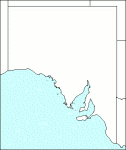|
Diuris x
Citation:
palachila, R. Rogers, Trans. R. Soc. S. Aust. 31:209 (1907).
Synonymy: Not Applicable Common name: Broad-tip (or broad-lip) diuris, broad-tip donkey-orchid.
Description:
Slender, glabrous, 10-40 cm high; tubers oblong-conical; leaves 2-5, narrow-linear or linear, somewhat lax, often reaching a length of 17 cm.
Flowers 1-3, on long and slender pedicels, yellow with brown markings; dorsal sepal c. 11 mm long, yellow, usually with brown blotches or dots chiefly on the outer surface near the base and around the margins; lateral sepals 10-15 mm long, green, linear, acuminate, spreading below the labellum, parallel or more rarely crossed; petals of similar colour and markings to the dorsal sepal, stalk greenish-brown, 4-5 mm long, lamina elliptical, c. 10.5 mm long, spreading; labellum c. 11 mm long, yellow with dark-brown dots, short linear splashes and blotches especially on its lower surface; lateral lobes c. 6.5 mm long (rather more than half the length of the mid-lobe), narrow-lanceolate with upturned dentate margins and outwardly curved free ends; mid-lobe spade- or shovel-shaped, apex crescentic; lamina with 2 widely separated raised longitudinal lines on the narrow base, ending abruptly in 2 teeth at the expanded part, thereafter merged into a central keel extending to the apex; anther as high as the viscid disk of the rostellum, rather flat with a very short point; lateral appendages of the column as high as the anther, oblong-falcate, anterior margins dentate.
Published illustration:
Gray ( 1971) Victorian native orchids 2:96; Pocock (1972) Ground orchids of Australia, pl. 59 as D. brevifolia, pl. 62 as D. emarginata.
|
|
Distribution:
|
Occurs singly or in small groups in fertile grassland or open forest generally with its putative parents D. maculata and D. lanceolata.
N.S.W.; Vic.; Tas.
|
Conservation status:
native
Flowering time: Aug. — Nov.
|

SA Distribution Map based
on current data relating to
specimens held in the
State Herbarium of South Australia
|
Biology:
The inconsistency in size and morphology of perianth-segments suggests that backcrossing may occur with both parent species.
Author:
Not yet available
|

